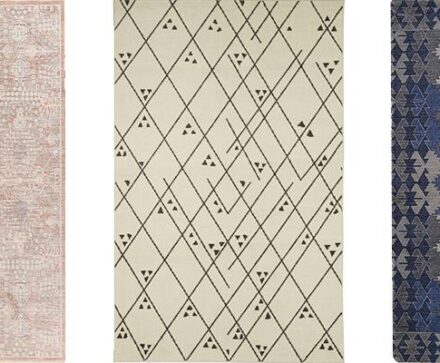Understanding and Using Tribal and Navajo Rugs
Tribal rugs and Navajo rugs have become more popular over time. What differentiates the two types of rugs and how can you display these beautiful pieces in your home? Find out now in this podcast with Sam Presnell, owner of The Rug Gallery.
John: Welcome to The Rug Gallery with Sam Presnell. The Rug Gallery is an Oriental rug company and Carpet Store in Cincinnati, Ohio. I’m John Maher. I’m here with the owner of The Rug Gallery, Sam Presnell. Hi, Sam.
Sam: Hi John.
Tribal Rugs and Navajo Rugs Defined
John: Today Sam, we’re talking about tribal and Navajo rugs. What are tribal and Navajo rugs? What does that mean?
Sam: Well, a lot of people look at [a tribal rug] and think that it’s a South Western or Navajo or Indian type of a rug and they really aren’t. A “tribal rug” to us in the rug trade is a rug that comes from the Middle East. And it’s usually by the nomadic tribes that are like sheep herders and they pretty much travel the arid lands and they graze sheep. And then of course, the rugs come as a byproduct of the wool from the sheep. The Navajo rug of course is the American Indian — mostly the people that were weaving were the Navajos. And it’s funny that when you think about it, they are basically sheep herders as well. The Navajos basically grazed and domesticated sheep, and of course they used their wool to make many things, among them rugs, which is part of their tradition and [these rugs] became very, very collectable.
The Differences Between Tribal Rugs and Navajo Rugs
John: Okay. What are some of the similarities and the differences between the Middle Eastern tribal rugs and the American Navajo rugs?
Sam: I think a lot of it is just based in the geometry and the straight lines that you see in geometric shapes. A lot of the things you would see in any tribal type situation, including the Indians, is you see geometric shapes representing what they see around them like the stars, the trees, the animals, things like that or interpreted into their designs. And it’s funny, because a lot of the people believe that the American Indians transferred out of Asia across the Bering Strait, which was connected in those days out of Russia into Alaska and then down into North America from that route. I’m not sure that’s correct or not for the American Indians, but I’ve read that in my history books. I see [a lot of] similarities between the American Indians and some of the tribal people in the Middle and Asia. I think they’re incredible how they have similarities.
Incorporating Tribal and Navajo Rugs into a Non-southwestern Home
John: Right. Really, that’s interesting. Do people like these tribal and Navajo rug styles even if their house is outside of the Southwest?
Sam: Yes. I think that’s an interesting thing. It truly is more of a collectable piece than any other type of Oriental rug I’ve ever seen. It has maintained its values and has been very, very collectable by a lot of people. A lot of people really appreciate it and it’s surprising that a lot of people will use them in different ways, even though they’re not in what you would call a Southwestern adobe home or something like that. You’ll be very traditional homes and people would just love it forever, I’d say more for the art sake of it than the history.
John: People seem to like that kind of folk art style or anything that appears like it’s handmade or made by indigenous people to a certain area. I think that’s maybe what people are gravitating toward.
Sam: Definitely. I think you’re correct in that. And I want to go back to that thing about the styles of homes and what Navajo rugs work well. A lot of times the rugs are used as wall-hanging. Lot of people used them just as they would a piece art on the wall. And it comes off very attractive. Most of the time we see these type of rugs usually what I would call more casual spaces.
John: Okay. I was going to ask what style of homes do tribal and Navajo rugs work best in. You’d say probably not your more modern and contemporary style homes, but anything else as long as it’s not too formal and it would fit in?
Sam: Yes. I have to say that I’ve seen them used in every kind of home imaginable. You wouldn’t expect that people would be into it. You get inside and it’s like, “Wow. They’ve got a really nice Southwestern collection going here.” And the sad part is that I’m not really able to appraise them because I don’t see or touch enough of the Navajo stuff. I do see a lot of the tribal Middle Easternstuff and have a good read for values and things of that nature [with those rugs]. I have a lot of people who ask me about values in Navajos and I pretty much direct them to people in the Southwest who are collectors. And I think that’s really the best route. In Navajo rugs, there’s a lot of what we call commercial-grade stuff that you saw at the trading post when you went out West with your mom and dad in the ‘60s or ‘50s. The ‘60s was a real big period for the Interstates and getting down and traveling the Route 66 through the Southwest. You’ll stop at the little trading posts and you’ll pick up a Navajo rug.
Well, there’s a lot of what I call that kind of rug, commercial grade. And there’s a lot of really fine, collectable chief blankets and just amazing cool stuff that is available. A lot of it is not really collectable and a lot of it is ridiculously priced, because it is so rare and so nice.
John: All right. That’s really great information, Sam. Thanks very much for speaking with me today.
Sam: All right, John. My pleasure.
John: And for more information about Sam, The Rug Gallery, and oriental Rugs and carpets, visit: ruggallerycincy.com. Or call 513-793-9505. And make sure you catch the latest episodes by subscribing to this podcast on iTunes.
And if you can take the time to give us a review on iTunes as well, we would appreciate that. See you next time on The Rug Gallery.


